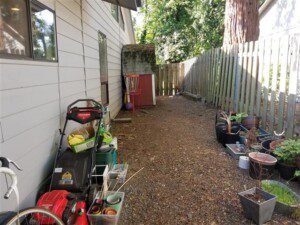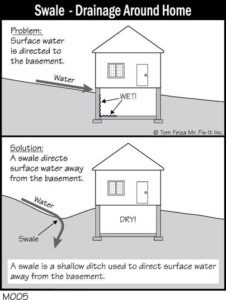
Negative grading around a home.
Proper drainage around a home is something that is often overlooked. Inadequate drainage could lead to foundation settling, moisture intrusion and mold growth issues. Many homes have improper grading issues that can allow water to drain up against a foundation.
For homes in areas with expansive soil (made up of clay) failure to control drainage around a foundation wall could allow the soil to expand and contract to the point that causes the foundation to shift and bow. This can also happen in areas that are very cold with the frost line below grade. If soil around the foundation is saturated with moisture when it freezes, the water in the soil will expand causing the foundation walls to heave and bow. Once foundation walls shift past a certain point, they can experience structural failure. If the home is built on a slab, moisture buildup around the foundation could case sinking and heaving of the floor. Repairing a foundation that has failed could cost tens of thousands of dollars. Foundation damage is especially unfortunate when the damage could have been prevented by simply controlling surface water drainage around the home.

Adding a swale to fix grading problems.
According to current building standards, the grade around a home should have a slope (away from the foundation) that drops at least 6 inches within 10 feet or at least ¼ inch per foot for 6 feet. Homes with negative or neutral slope towards the foundation are vulnerable to foundation settling and moisture intrusion issues.
In cases where correcting the grade around the home is too difficult or expensive, some drainage contractors will recommend installation of a crawlspace low point drain, or sump pumps that can allow water to drain or be pumped out of the home and into an intentional drainage system. However, in many cases, a better option is to install exterior drains that will prevent water from making contact with the foundation wall altogether. This can often be achieved by installing a “French Drain”, or a swale that can allow water runoff to be controlled away from the foundation wall before it can reach it.
French drains can be fairly simple systems that are easy to install, but require lots of labor. That’s why if you hire a contractor to install a French drain, it can be very expensive. Many homeowners can install a French drain with some time and effort.
French drains consist of drainage pipes and gravel that are installed in trenches around the home. The idea is to collect water and route it away from the home before it can reach the foundation.
If you do decide to install a French drain yourself, it is important to check with your local governing jurisdiction in order to determine if permits are needed. Also, you should have a utility locate performed (the home checked for underground utilities). Most counties and cities have a free service that can be easily scheduled, that includes having the ground marked where underground utilities are routed. This way people digging into the ground are aware of locations that may have pipes or wires running underground that may be vulnerable to damage.
Check out the video below for more information about how to install a French drain.
